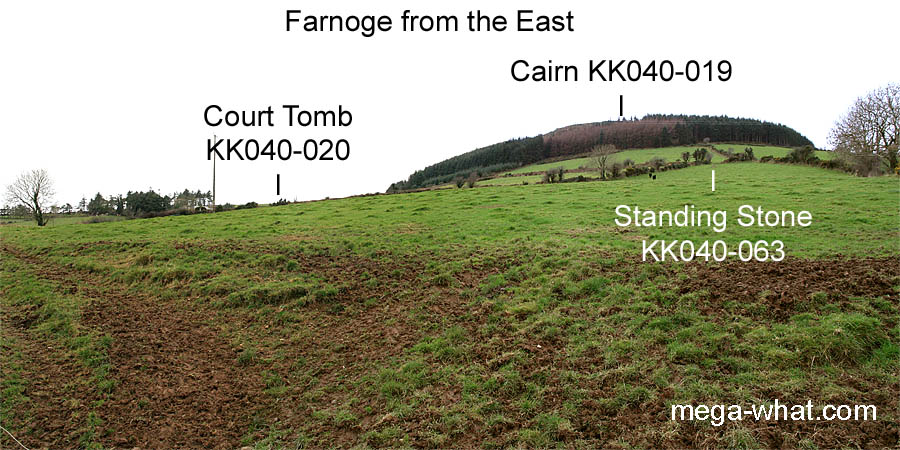 On the eastern side of Tory Hill in Co. Kilkenny, Farnoge Court Tomb is about 12km south-west of New Ross and 10km north of Waterford.
On the eastern side of Tory Hill in Co. Kilkenny, Farnoge Court Tomb is about 12km south-west of New Ross and 10km north of Waterford.
Embedded into the eastern slopes of Tory Hill is a long & narrow structure that appears to have courts at both ends. Overall axis c.35°/215°. Standing Stone KK040-063 (axis N/Sish) c.150m west-north-westwards up the hillslope is a possible target / secondary observing position as is Cairn KK040-019 on the hilltop.
 North is at the intersect of local ground and far horizons [Pic] and South is in a saddle [Pic].
North is at the intersect of local ground and far horizons [Pic] and South is in a saddle [Pic].
Eastwards, the south lunisticeLunistices are the most northerly and southerly moons of the month. The lunar equivalent of solstices - more. zone spans a dip, ending on a hilltop. The equinox is at the lowest point of the eastern horizon and the north lunisticeLunistices are the most northerly and southerly moons of the month. The lunar equivalent of solstices - more. zone ends on another hilltop.
Westwards, the south llunisticeLunistices are the most northerly and southerly moons of the month. The lunar equivalent of solstices - more. zone is on the slope leading up to Tory Hill which has the equinox on its top. Everything else is on a steep and local north facing slope but keen eyes, despite the bushes, see the lunisticeLunistices are the most northerly and southerly moons of the month. The lunar equivalent of solstices - more. zone spanning a slight rise.
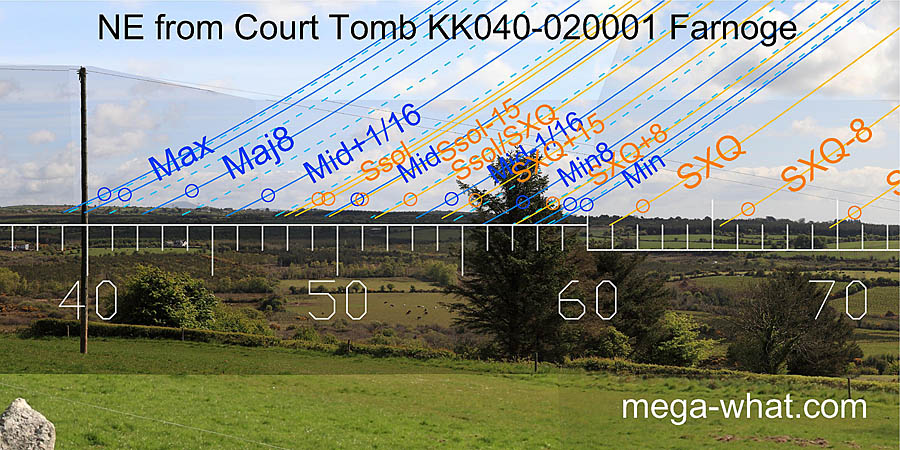 The north-eastern tomb axis [Pic] is perhaps a few degrees beyond the lunar maximum
but there is a good hit for the major eighth on a distant mountain top that would be visible whatever the tree cover on intervening ground.
The north-eastern tomb axis [Pic] is perhaps a few degrees beyond the lunar maximum
but there is a good hit for the major eighth on a distant mountain top that would be visible whatever the tree cover on intervening ground.
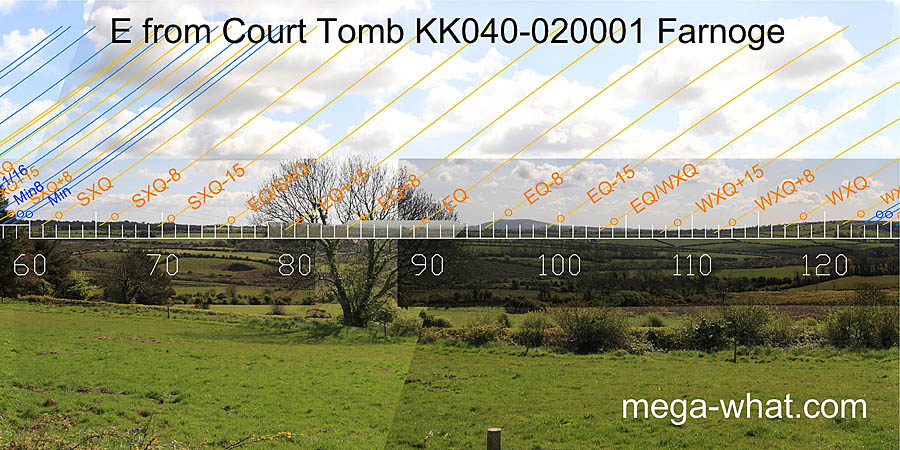 Eastwards, the equinox is on a nearer hill in front of a distant dip.
Again there are good markers on a distant mountain, this time for the quarter and half months south of the equinox as well as the quarter-month to its north.
Eastwards, the equinox is on a nearer hill in front of a distant dip.
Again there are good markers on a distant mountain, this time for the quarter and half months south of the equinox as well as the quarter-month to its north.
 WXQ-8 is on a nearer hilltop, providing a useful marker for the beginning of the lunisticeLunistices are the most northerly and southerly moons of the month. The lunar equivalent of solstices - more.
range.
This runs down the slope, with the midpoint at a prominent hump/step and the next sixteenth in the following dip.
The major end of the cycle is then on a local upslope which, being north facing, stretches out the rising positions giving the possibility of greater precision.
WXQ-8 is on a nearer hilltop, providing a useful marker for the beginning of the lunisticeLunistices are the most northerly and southerly moons of the month. The lunar equivalent of solstices - more.
range.
This runs down the slope, with the midpoint at a prominent hump/step and the next sixteenth in the following dip.
The major end of the cycle is then on a local upslope which, being north facing, stretches out the rising positions giving the possibility of greater precision.
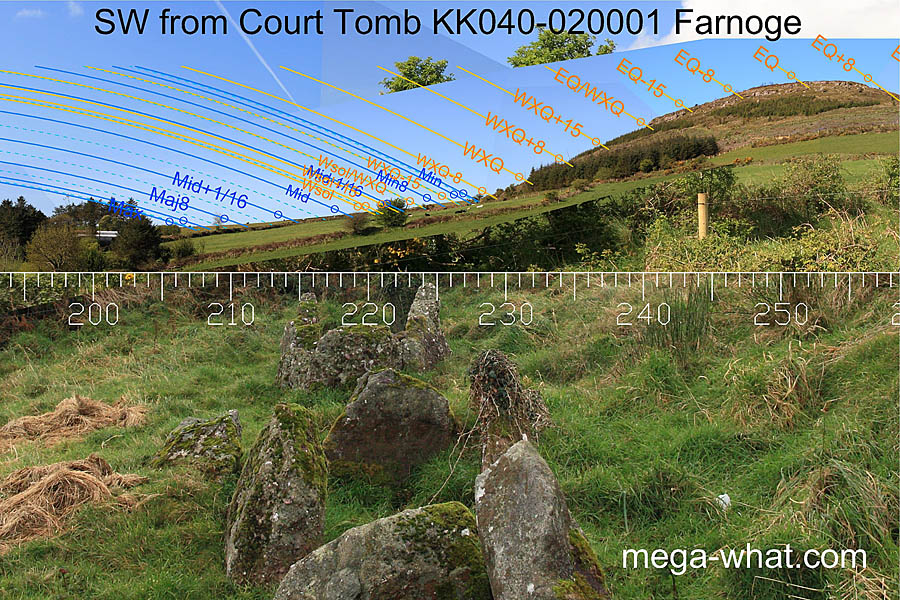 The south-western view is towards gently rising and fairly smooth local ground.
This slope terminates at the basal step of Tory Hill which marks the lunar minor standstillLunistice positions vary cyclically over an 18.6 year period but are fairly static for more than a year at either end of the range
and also effectively WXQ-8.
So the entire lunisticeLunistices are the most northerly and southerly moons of the month. The lunar equivalent of solstices - more.
range and all the winter sunrises occur on this stretch.
The south-western view is towards gently rising and fairly smooth local ground.
This slope terminates at the basal step of Tory Hill which marks the lunar minor standstillLunistice positions vary cyclically over an 18.6 year period but are fairly static for more than a year at either end of the range
and also effectively WXQ-8.
So the entire lunisticeLunistices are the most northerly and southerly moons of the month. The lunar equivalent of solstices - more.
range and all the winter sunrises occur on this stretch.
The tomb axis indicates the general direction of winter solstice / lunar-mid point. This axial view shows the western court and central chamber. Survey was conducted from the space between these.
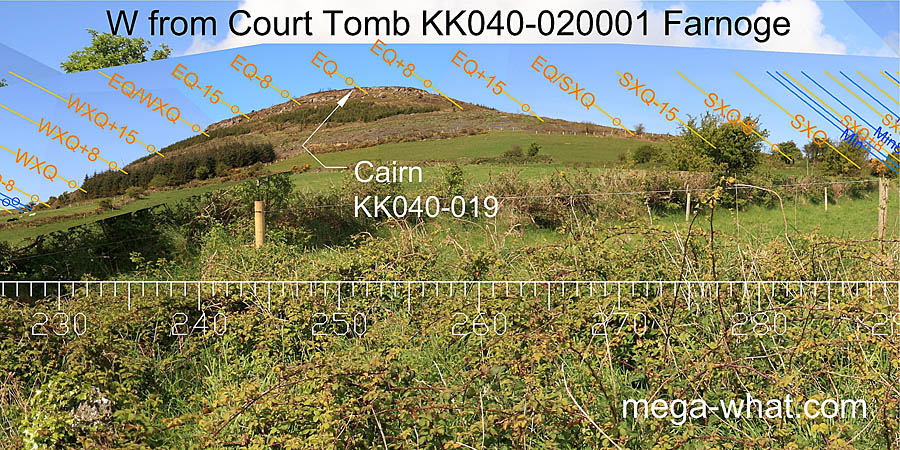 The western horizon rises quite high and is formed by Tory Hill. There was a cairn on the top and this tomb was built on the flank.
The equinox is on the summit and the half-way point between the equinox and winter cross-quarters are marked by a prominent rock step on the northern slope.
The western horizon rises quite high and is formed by Tory Hill. There was a cairn on the top and this tomb was built on the flank.
The equinox is on the summit and the half-way point between the equinox and winter cross-quarters are marked by a prominent rock step on the northern slope.
 The north-western horizon is a fairly smooth local slope, now much obscured by hedges. It looks as though Standing Stone KK040-063
might have been intended to cut the horizon somewhere in the region of the lunar midpoint / summer solstice sunset.
Bear in mind that the overall length of the tomb is about 15m so moving from one end to the other would have a noticeable effect on this local western horizon.
The Standing Stone is only about 150m away, so using the tomb as a baseline would allow its position against the sky to be varied by as much as 5 or 6 degrees.
The north-western horizon is a fairly smooth local slope, now much obscured by hedges. It looks as though Standing Stone KK040-063
might have been intended to cut the horizon somewhere in the region of the lunar midpoint / summer solstice sunset.
Bear in mind that the overall length of the tomb is about 15m so moving from one end to the other would have a noticeable effect on this local western horizon.
The Standing Stone is only about 150m away, so using the tomb as a baseline would allow its position against the sky to be varied by as much as 5 or 6 degrees.
What we are looking at here is probably the early clearance of a local area. Clearing down from the top into the existing woodland. One has to wonder if we are looking at something like the juxtaposition of Passage Tomb and Cairn seen further up the same river system at Deerpark.
Ballynamona Lower, on the coast, 50km to the south-west is the only other known Court Tomb in this general area.
References
- Archaeological Survey of Ireland, record details. www.archaeology.ie/archaeological-survey-ireland
